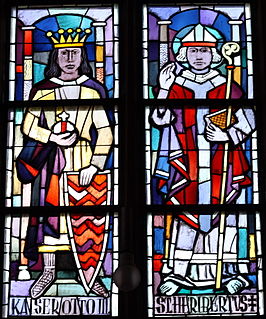
Year 994 (CMXCIV) was a common year starting on Monday of the Julian calendar.

Omar Khayyam was a Persian mathematician, astronomer, philosopher, and poet. He was born in Nishabur, in northeastern Iran, and spent most of his life near the court of the Karakhanid and Seljuq rulers in the period which witnessed the First Crusade.
Abu'l-Faḍl Muḥammad ibn Ḥusayn Bayhaqī, better known as Abu'l-Faḍl Bayhaqi, was a Persian secretary, historian and author.

The Ghaznavid dynasty was a Persianate Muslim dynasty of Turkic mamluk origin, at their greatest extent ruling large parts of Iran, Afghanistan, much of Transoxiana and the northwest Indian subcontinent from 977 to 1186. The dynasty was founded by Sabuktigin upon his succession to rule of the region of Ghazna after the death of his father-in-law, Alp Tigin, who was a ex-general of the Samanid Empire from Balkh, north of the Hindu Kush in Greater Khorasan.

The Danishmend or Danishmendid dynasty was a Turkish Beylik that ruled in north-central and eastern Anatolia from 1071/1075 to 1178. The dynasty centered originally around Sivas, Tokat, and Niksar in central-northeastern Anatolia, they extended as far west as Ankara and Kastamonu for a time, and as far south as Malatya, which they captured in 1103. In early 12th century, Danishmends were rivals of the Seljuk Sultanate of Rum, which controlled much of the territory surrounding the Danishmend lands, and they fought extensively against the Crusaders.

The Ghurids or Ghorids were a dynasty of Iranian origin from the Ghor region of present-day central Afghanistan, but the exact ethnic origin is uncertain. The dynasty converted to Sunni Islam from Buddhism, after the conquest of Ghor by the Ghaznavid sultan Mahmud of Ghazni in 1011. The dynasty overthrew the Ghaznavid Empire in 1186 when Sultan Mu'izz ad-Din Muhammad of Ghor conquered the last Ghaznavid capital of Lahore.

Clifford Edmund Bosworth FBA was an English historian and Orientalist, specialising in Arabic and Iranian studies.
Abu'l Faḍl is an Arabic male given name which also occurs in place-names. It means father of virtue. It is variously transliterated as Abu'l-Fadl, Abu'l-Fazl, Abul Fazal etc. It is also used in Iran and Azerbaijan, usually in the form of Abolfazl, or Abulfaz.
Abū Bakr Aḥmad ibn Ḥusayn Ibn 'Alī ibn Mūsa al-Khosrojerdi al-Bayhaqi (Arabic) , البيهقي also known as Imām al-Bayhaqi was born c. 994 CE/384 AH in the small town of Khosrowjerd near Sabzevar, then known as Bayhaq, in Khurasan. During his lifetime, he became a famous Sunni hadith expert, following the Shafi'i school in fiqh and the Ash'ari school of Islamic Theology.
Tārīkh-i Bayhaqī is a history book written by Abul-Fazl Bayhaqi, in Persian, in the 11th century CE. Much of this extensive work is lost, but its remains is the most important source on the history of the Ghaznavid Empire. The work is of literary value as well due to its unique style of narration.
Ali-Akbar Fayyaz was a distinguished professor of Islamic heresiography and Persian language and literature at Tehran University and the Ferdowsi University of Mashhad. Fayyaz was born into a family of Shiite clerics in Mashhad, northeastern Iran. His father, Sayyid Abdul-Majid Thaqat al-Islam, was his first teacher inculcating in him a profound knowledge of Arabic and the basics of Islamic sciences. Fayyaz completed his official studies in Mashhad and secured a job in the administration of the Mashhad holy shrine endowments. In 1929, Fayyaz became the principal at the Shah-Reza High School, one of the first and most accredited modern schools in Mashhad. In 1936, the Ministry of Education appointed him to the post of principal at the Teachers' Training College in Mashhad.

Haresabad is a village in Qasabeh-ye Gharbi Rural District, in the Central District of Sabzevar County, Razavi Khorasan Province, Iran. At the 2006 census, its population was 1,339, in 368 families.
Amīr Sūrī was the king of the Ghurid dynasty from the 9th-century to the 10th-century. He was a descendant of the Ghurid king Amir Banji, whose rule was legitimized by the Abbasid caliph Harun al-Rashid. Amir Suri is known to have fought the Saffarid ruler Ya'qub ibn al-Layth al-Saffar, who managed to conquer much of Khurasan except Ghur. Amir Suri was later succeeded by his son Muhammad ibn Suri. Although Amir Suri bore an Arabic title and his son had an Islamic name, they were both Buddhists and were considered pagans by the surrounding Muslim people, and it was only during the reign of Muhammad's son Abu Ali ibn Muhammad that the Ghurid dynasty became an Islamic dynasty.
Abu Sahl Muhammad ibn Husayn Zawzani, better known as Abu Sahl Zawzani, was a Persian statesman who served as the chief secretary of the Ghaznavids briefly in 1040, and later from 1041 to an unknown date. Zawzani died in 1054.
Zahir al-Din Abu'l-Hasan Ali ibn Zayd-i Bayhaqi also known as Ibn Fondoq was an Iranian polymath and historian of Arab descent. He is the author of Tarikh-i Bayhaq.
Tarikh-i Bayhaq is a book on the history of Bayhaq, written in the Persian language in the 12th century, by Abu'l-Hasan Bayhaqi.

Shuab ul Iman,, is a Hadith book, and has been compiled by Imam Al-Bayhaqi.

Aush Jushpare is a type of Aush, commonly cooked in Khorasan, Gonabad, Ferdous and Sabzevar in Iran.it is similar to the chines and Japanese Jiaozi Historian Bayhaqi (-1077) mentioned about Aush Jushpare in his book "Tarikh-i Bayhaqi". Aush Jushpare is one of the oldest Aush, but since it takes a lot of time for preparation, it is not commonly eaten now. It is rather a dish of hospitality, which people eat on the occasion of special gatherings or festivals. Traditional guest house restaurant serves Aush Jushpare as local specialty. Aush Jushpare was registered as intangible heritage of Iran in 5 January 2021..








